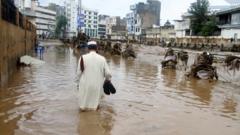In the wake of heavy monsoon floods, a somber crisis is unfolding in Pakistan and Pakistan-administered Kashmir, where the death toll has surged past 300 in just a matter of days. The majority of fatalities have been reported from the northwestern Khyber Pakhtunkhwa province, with a notable number of victims also emerging from Pakistan-administered Kashmir and the northern Gilgit-Baltistan region.
As the nation's disaster authorities continue to assess the devastating impact of the floods, at least 307 deaths have been confirmed, along with significant damage to homes and infrastructure. In Khyber Pakhtunkhwa alone, authorities reported that at least 74 homes have been destroyed. In a tragic turn of events, a rescue helicopter crashed during operations due to severe weather, claiming the lives of all five crew members on board.
Survivors recount harrowing experiences, with one resident from Buner describing the terrifying moments as the floods swept through his community. “It was as if the mountain was sliding," he recounted, emphasizing the overwhelming power of the water and the imminent danger felt by residents.
Local officials have declared numerous areas disaster zones as heavy rainfall is predicted to continue until at least August 21. The chief minister of Khyber Pakhtunkhwa, Ali Amin Gadapur, expressed his condolences and called for a day of mourning amid the chaos. Meanwhile, rescue efforts are hindered by the challenging weather conditions.
In the Indian-administered region of Kashmir, a fresh wave of devastation struck as rescuers discovered bodies buried in mud and debris after floods ravaged a village, resulting in at least 60 additional fatalities.
With monsoon season typically accounting for a large portion of South Asia’s annual precipitation, the frequency and severity of flooding incidents have raised alarm among scientists. This year alone, monsoon rains have so far led to 650 fatalities across the region. Climate change is cited as a key factor making these extreme weather events increasingly likely, exacerbating previously precarious conditions in already vulnerable mountain communities.
As authorities await further information about the causes of these destructive floods and landslides, the broader implications of climate change on glacial melt and rainfall patterns continue to pose significant challenges for the region.
As the nation's disaster authorities continue to assess the devastating impact of the floods, at least 307 deaths have been confirmed, along with significant damage to homes and infrastructure. In Khyber Pakhtunkhwa alone, authorities reported that at least 74 homes have been destroyed. In a tragic turn of events, a rescue helicopter crashed during operations due to severe weather, claiming the lives of all five crew members on board.
Survivors recount harrowing experiences, with one resident from Buner describing the terrifying moments as the floods swept through his community. “It was as if the mountain was sliding," he recounted, emphasizing the overwhelming power of the water and the imminent danger felt by residents.
Local officials have declared numerous areas disaster zones as heavy rainfall is predicted to continue until at least August 21. The chief minister of Khyber Pakhtunkhwa, Ali Amin Gadapur, expressed his condolences and called for a day of mourning amid the chaos. Meanwhile, rescue efforts are hindered by the challenging weather conditions.
In the Indian-administered region of Kashmir, a fresh wave of devastation struck as rescuers discovered bodies buried in mud and debris after floods ravaged a village, resulting in at least 60 additional fatalities.
With monsoon season typically accounting for a large portion of South Asia’s annual precipitation, the frequency and severity of flooding incidents have raised alarm among scientists. This year alone, monsoon rains have so far led to 650 fatalities across the region. Climate change is cited as a key factor making these extreme weather events increasingly likely, exacerbating previously precarious conditions in already vulnerable mountain communities.
As authorities await further information about the causes of these destructive floods and landslides, the broader implications of climate change on glacial melt and rainfall patterns continue to pose significant challenges for the region.


















